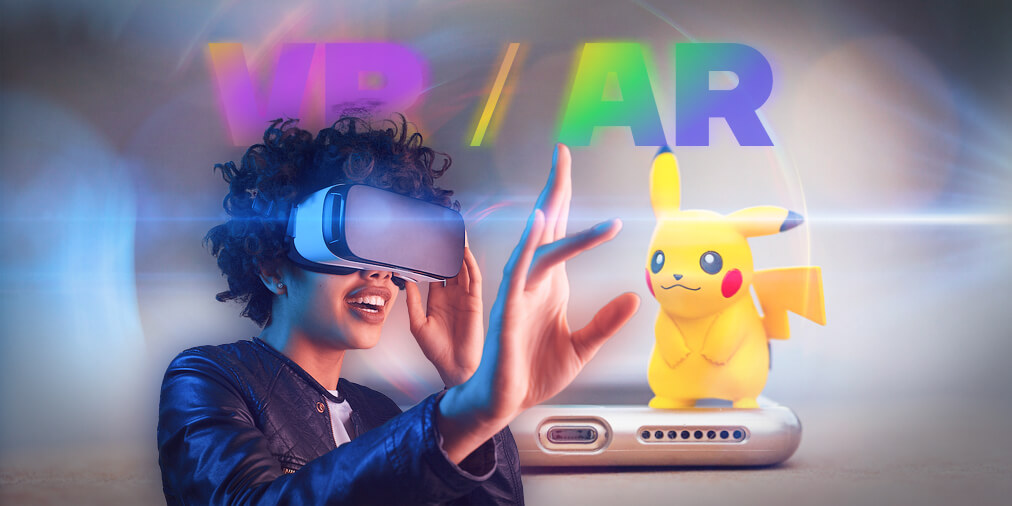VR and AR adoption


VR and AR
Virtual reality (VR) and augmented reality (AR) allow users to experience digital content in simulated and real-world environments. These technologies were predicted by science fiction in the 1930s and have been around in some form since the 1960s. (For a nearly 30-year-old Hollywood take on VR, see the oddball 1994 Michael Douglas sci-fi movie Disclosure.)
Still, VR and AR have only recently become commercially available — and affordable — for the average consumer. If tech in the 2020s is set to show us anything, it may be just how many commercial and recreational applications are possible using VR and AR technology.
If it isn’t already here, more widespread exploration of an immersive cyber-world is certainly on the horizon.
What is VR and AR adoption?
To understand adopting VR and AR, consider shopping. The Metaverse is already embracing retail spaces. Metaverse destinations like Decentraland and The Sandbox are not just VR spaces but are available for anyone who wants to sign on. The way companies use them indeed points toward increasing commercial adoption of virtual spaces.
Online retailers can create virtual stores that allow customers to browse products and make purchases. This can be especially useful for people who do not have easy access to physical stores. Another potential application is tourism. Virtual reality could create virtual tours of popular tourist destinations or historical landmarks. This would be beneficial for people who cannot afford to travel or who live in countries that are unsafe to visit.
Then there’s gaming. Augmented reality can also be used in gaming and provide a more immersive experience than traditional games. There are already popular AR games widely available, like Pokémon Go.
It’s not a stretch to say that by 2030, it’s highly likely that VR and AR will be well on the way to replacing traditional video games.
Virtual reality already extends into previously unexpected realms, such as mental health. VR has proven helpful to soldiers struggling with the symptoms of PTSD. Conversely, it has also proven helpful in military training, providing a chance to safely prepare for mundane tasks and real-world operations. And heads-up displays, a basic form of AR, have been standard in some military aircraft for years.
It isn’t just that VR and AR adoption in so many spheres is inevitable; it’s already happening.
Understanding VR and AR Adoption
As virtual reality and augmented reality continue to improve and become more widespread, it becomes more critical that we better understand these technologies as we incorporate them into our lives. They already have different uses. VR is about total immersion in a digital world — very well-suited to entertainment, gaming, and education. By overlaying digital information onto the real world, AR shows its potential not just for many of the same applications but also for assisting us as we go through our everyday lives.
Examples might include heads-up displays not just for military pilots but for travelers navigating unfamiliar cities, perhaps sent to smartglasses, helping to reduce the number of people staring at their phones as they walk city streets. Augmented reality could present real-time information about various locations to help you determine if you want to go there in the first place. Unfortunately (depending on your perspective), AR also provides opportunities for more targeted, possibly intrusive advertising.
With ever-faster graphics processing and lower and lower latency 5G signals, the ways in which VR and AR can improve our lives will only continue to expand.
The potential is enormous. As technology continues to evolve, so will its uses. Understanding and using both virtual reality and augmented reality now will help shape their future development and ultimate utility.
« Back to Glossary IndexDisclaimer
In line with the Trust Project guidelines, please note that the information provided on this page is not intended to be and should not be interpreted as legal, tax, investment, financial, or any other form of advice. It is important to only invest what you can afford to lose and to seek independent financial advice if you have any doubts. For further information, we suggest referring to the terms and conditions as well as the help and support pages provided by the issuer or advertiser. MetaversePost is committed to accurate, unbiased reporting, but market conditions are subject to change without notice.
About The Author
Managing editor, mpost.io. Former Deputy Digital Editor, Maxim magazine. Bylines in Observer, Inside Hook, Android Police, Motherboard. Author of official "Better Call Saul" tie-ins "Don't Go to Jail," and "Get off the Grid."
More articles

Managing editor, mpost.io. Former Deputy Digital Editor, Maxim magazine. Bylines in Observer, Inside Hook, Android Police, Motherboard. Author of official "Better Call Saul" tie-ins "Don't Go to Jail," and "Get off the Grid."


















































